Peter Cawdron's Blog, page 3
March 15, 2024
100 Free Scifi Ebooks
What are you doing this weekend? How about exploring a bunch of free ebooks to find some new authors? Fellow science fiction author Carolynn Gockel has arranged this bulk giveaway for two days only, so what are you waiting for? Dive into this smorgasbord of ebooks before it’s gone! There’s something for everyone.
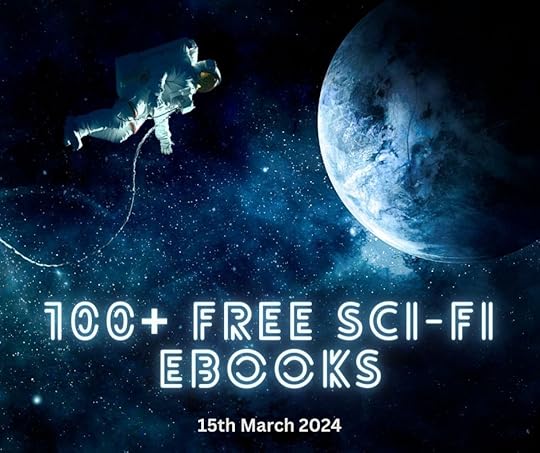
January 31, 2024
The Absolute Best, Top Ten Science Fiction Books Ever Written!
Sorry to disappoint, but there’s no such list in this article. Any list like that is a work of fiction in itself.
As a culture, we’re obsessed with being #1 or having nice, neatly ordered lists of The Best Movies Ever, or the best books, etc, but these are a fallacy. You can have a #1 football team winning the Superbowl, but you cannot have a #1 book (even though Amazon and the New York Times try), and the reason is that it’s not a competition. Literature is not a game to be won or lost. It’s art.
Usain Bolt holds the record as the fastest man in the 100M sprint in the Olympics. Who came second? Third? What was the difference in their times? Milliseconds? No one knows. No one cares. All we, as a culture, care about is #1, and that’s really shortsighted.
Who was the first person to climb Mt. Everest, the highest mountain in the world?
The history books will tell you it was Sir Edmund Hillary, but Sir Edmund Hillary himself will tell you no such lie. He often spoke of reaching the summit at the same time as his sherpa, Tenzing Norgay. They both risked their lives in the attempt. They both helped each other. They needed each other. They both summited at the same time.
Who was the first person to walk on the Moon?
Again, the history books will tell you it was Neil Armstrong, but both Neil and Buzz touched down in the Eagle lunar module at exactly the same time. Both of them risked their lives in the attempt, as did Michael Collins in orbit around the Moon. They all needed each other. Neil hated being called the first man on the Moon because he knew it was a lie. Oh, they say, but he was the first one to walk on the surface? Really? Was he? Did the soles of his feet ever actually touch the lunar dust? Whether it was the landing pads on the Eagle or the thick rubberized boots protecting their feet, neither man actually ever touched the surface.
But we’re obsessed with firsts. We’re obsessed with lists. And it is to our detriment. Whenever some blogger posts a list of their top ten science fiction novels (and I’m guilty, I’ve done this myself), I lament what is lost. There are always the usual suspects in these lists, H.G. Wells, Arthur C. Clarke, Frank Herbert, etc., but what people forget is that there was a time when these works were unknown. Now, they crowd out other unknown works. Instead of encouraging people to read broadly and widely, readers are channeled into a narrow space we call The Classics and ignore anything that hasn’t been established for at least a decade or two.
What’s better? Sushi or steak? When you stop and think about it, the question itself is insulting. Ranking them is absurd.
I think of literature like ice cream. What’s your favorite flavor? It really doesn’t matter whether I agree with you or not because it is not a competition. No one flavor is better than another. We enjoy ice cream for what it is, regardless. Like books, ranking flavors is an exercise in futility. Today, I might enjoy mint. Tomorrow, caramel. Neither is right or wrong. Neither is better.
I hate the way books are rated on Amazon. I understand there’s a need to provide independent, objective insights to help other readers make up their minds about whether they might enjoy a novel, but the ranking system doesn’t cater for different tastes. Reviews are great, but even they are limited. In my experience, less than 2% of all readers leave a review, which means reviews do NOT represent the bulk of readers but rather the outliers (those who love or hate the book). It’s like reviewing ice cream. “Mint! It tastes like weeds in my garden. One star!” The subjective nature of one book to another makes comparisons largely meaningless. When I read reviews of my books, I learn far more about the reviewer than I do about the book itself!
I would love it if Amazon released objective stats about books rather than subjective ones. For example, Amazon tracks every page that is read in books within Kindle Unlimited. It would be fascinating if they published the average time people take to read a book, as that would tell you whether it’s compelling or only mildly interesting. Another fascinating statistic would be the drop-out rate. How many people read the entire book? How many get bored and move on to something else? Also, information such as “90% of those who read Hail Mary from cover to cover, also read XYZ from cover to cover.” Details like these would be far more useful than merely saying this book has 1000 reviews for an average of 4.2 stars while that one has 500 reviews for 4.3 stars, as that’s meaningless. There’s no context behind the stars.
I consider literature as art. It’s meaningless to compare the Mona Lisa to Monet’s Waterlilies or Picasso’s Sunflowers. They’re all stunning and wonderful and beautiful in their own right. Now, not every painting makes its way into a museum, so perhaps there is a degree of gatekeeping to narrow the field, and perhaps there are other, equally worthy paintings that never go on display, so there are no easy answers, but comparing them is futile.
Whatever you’re reading, I hope you’re enjoying it like an ice cream on a hot summer day 


January 29, 2024
Life in Outer Space?
My thoughts on alien life are simple. Ask yourself this question: Is there life in outer space?
This is where people think there’s some debate, but there’s actually no debate at all. The answer is an unequivocal yes.
We know with 100% certainty that there is life in outer space because there’s life on Earth, and Earth is in outer space. Now, it might sound as though I’m cheating you out of an answer, but this point is actually quite relevant. For thousands of years, our cultures and religions have been ego-centric, thinking of themselves as the center of everything. And so we see Earth as one thing and outer space as something else when that’s not true. Earth is a tiny planet in a modestly sized solar system, orbiting a rather ordinary star on a spiral arm of an unassuming galaxy that is one among roughly four hundred billion other galaxies. The real question is… Is there any other life in outer space? And the answer is, if there’s life here, there’s no reason to assume there couldn’t be life elsewhere.
Statistically, it would be highly unlikely that Earth is the only place with life/intelligent life.
Think about how rare black holes are compared to stars. Then think about how rare it is for two black holes to collide. When the LIGO gravitational wave detector was first set up, the team thought that, if they were lucky, they might observe one or two collisions a year. When the scientists switched LIGO on, they found four collisions in the first week! And LIGO can only detect gravitational waves from a very small band of black holes, not all black holes, and yet the universe is ringing with these collisions happening all the time!
What this highlights is how, when you have astronomically large numbers, even rare events can be quite common. It sounds contradictory, but the same holds true for things like people dying from falling off a ladder or slipping over in the bathroom. You or I would consider this a rare, unlikely event, but 45,000 people die from falls in the US each year. It’s not that bathrooms and ladders are inherently dangerous so much as that there’s an astronomically large population of 330,000,000 people in the US, so this seemingly rare event (0.0015%) is actually quite common.
When you consider the size of the universe, there are 10^26 stars, that’s 100,000,000,000,000,000,000,000,000 stars! So how frequent is life? Well, it is at least one in 10^26 as we’re here, but is it really that low? What if it was astonishingly rare, occurring only around one in a billion stars? Although that sounds rare, if it were true, then there would be 200 instances of life arising in just our galaxy alone as we have somewhere around 200 billion stars!
Or what if life was rarer still, at just one in a trillion stars? Well, then there would still be 100,000,000,000,000,000 planets teeming with life in the universe (10^17), but being one in a trillion, there would only be one in our galaxy (as we only have around 200 billion stars, so we’d be an outlier).
In short, I think there is no reason not to think there’s life elsewhere; it’s probably just so remote we’ll never find it, given the sheer size of the universe. Jill Tartar, the head of NASA SETI, said, “If you equate all the stars in the universe to the oceans of the world, then we’ve searched the equivalent of a bathtub looking for life.”
I suspect life is out there, but I doubt we’ll ever find it. If our bathtub is on the shore of a small bay on the coast of Norway, and life is teeming in the Pacific, it’s likely we’ll never see it at all.
Imagine you’re an extraterrestrial looking for other intelligent life forms in the galaxy, and you suspect there’s someone like us out there, so you decide to listen for us. What would you hear? Nothing. That tiny blue dot in the image below is the extent of how far our radio and television have reached. Unless ET was in a nearby star, something that doesn’t seem likely, they’d have no idea about us for thousands to tens of thousands of years. Given our galaxy is 100,000 light-years in diameter, if they’re holding a party on the other side of the Milky Way, and even if they had sensitive enough equipment, they won’t know about us for a very long time.
Is there life in outer space? Yes—us! Is there any other life in outer space? Probably, but it may be so isolated that it’s impractical to ever detect, let alone visit.
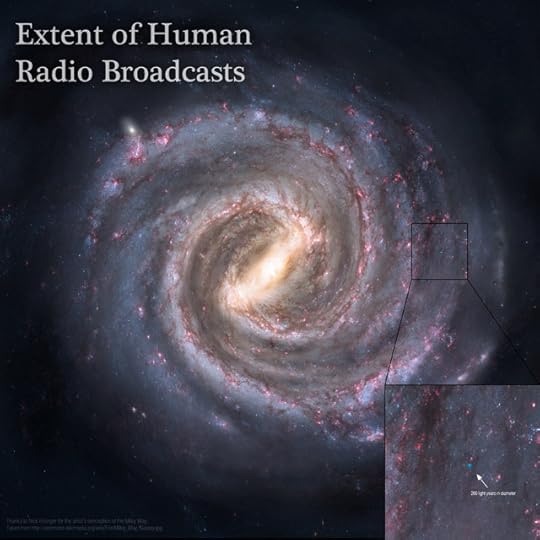
January 28, 2024
My advice to aspiring writers
Was it natural for me to become an author? Kind of, although it was a long, torturous road.
In high school, I and a couple of friends were thrown out of our English class for talking and disrupting the session. Our teacher, Mrs Revell, told us to sit in the corridor and write out lines. We were told to fill two pages with the line, “I must not talk in class.” My friends started dutifully doing what they were told. I couldn’t. Mindless repetition was abhorrent to me. But I had to write two pages of something. So, I wrote the screenplay for a story called The Persecution of a Humble Student. Needless to say, it was very silly and was written like a movie trailer…
In a world overrun by inept teachers, one student rises above the bleating of the sheep around him… Stephen Speilberg presents a 20th Century Fox film adapted from the best-selling autobiographical essay. Special effects by Light and Magic, the team that brought you Star Wars. A John Williams soundtrack…
…and on and on it went. The actual story was just our hero saying the line he was told to write once, and then the credits roll, with actors being set against characters, film locations listed, etc. Anyway, at the end of the class, my friends thought I was mad. They handed in their lines to the very grumpy Mrs Revell. She snatched my essay from me, started reading, went red in the face with anger, and then burst out laughing. I was expecting a detention after school. I got a kind smile instead. So that was my first foray into creative writing 
I dabbled a little after that, but work and family life became the focus for a few decades. In my forties, I came to the shocking realization that my favourite science fiction author was actually an anti-science fiction writer. I’d read all of Michael Crichton’s works and saw a theme running through them that was odious. Science was not to be trusted. It was Pandora’s box. Opening it would only ever lead to tragedy. Whether it was Jurassic Park, Timeline, Prey or State of Fear, science was the bad guy. And what’s worse, his sentiments were echoed in society, with the public increasingly becoming distrustful of even basic science. Although I loved the movie, Jurassic Park, it contained the line, “Your scientists were so preoccupied with whether they could, they didn’t stop to think if they should,” which is a gross misrepresentation of the way science works. The novel is worse, with page after page of raving madness dumping on the supposed arrogance and inability of science to correct itself.
In the words of Shakespeare, I’d say to Michael, “The lady doth protest too much, methinks.” Far from tearing down some supposedly corrupt edifice, Michael Crichton was exposing his own shortcomings. But being a cultural icon, his words carried tremendous weight and undermined serious science like Climate Change (his novel State of Fear is a right-wing fantasy dismissing the evidence). I told someone my thoughts on his writing, and they said, “Well if you think you can do better, why don’t you?” So I wrote Anomaly. I don’t think it’s better than any of Crichton’s works, but then, I don’t think vanilla ice cream is better than chocolate. They both have their own place. And since then I’ve tried to keep my stories science-positive and socially responsible.
My advice to aspiring writers is to realize writing is a marathon, not a sprint. Don’t be lulled onto the rocks by the siren call of a debut breakout novel. Having written over forty books, I only now feel comfortable as a writer. I look back at my earlier works and can see how I’ve grown. With each book you write, you’ll learn more you can take into the next novel. Build a back catalog of stories people will love to read, but don’t fall for the myth of appearing in the New York Times. Write because you love to read and not for fame or acclaim. Write because you long to explore ideas that appear as mere shadows on the edge of your consciousness and need to be captured to be understood.
A writer is a very slow reader, plodding through endless, blank, white pages, leaving a trail of words behind them.

January 26, 2024
Finding Exoplanets with Splunk

This is an article I wrote back in 2019 that appeared on a technical website, showing how an IT log monitoring tool called Splunk could be used to find exoplanets. It’s a good example of how NASA, ESA, etc, make their data openly available for anyone to play with… and find their own planet!
————————————
Splunk is a software platform designed to search, analyze and visualize machine-generated data, making sense of what, to most of us, looks like chaos.
Ordinarily, the machine data used by Splunk is gathered from websites, applications, servers, network equipment, sensors, IoT (internet-of-things) devices, etc, but there’s no limit to the complexity of data Splunk can consume.
Splunk specializes in Big Data, so why not use it to search the biggest data of all and find exoplanets?
What is an exoplanet?An exoplanet is a planet in orbit around another star.
The first confirmed exoplanet was discovered in 1995 orbiting the star 51 Pegasi, which makes this an exciting new, emerging field of astronomy. Since then, Earth-based and space-based telescopes such as Kepler have been used to detect thousands of planets around other stars.

At first, the only planets we found were super-hot Jupiters, enormous gas giants orbiting close to their host stars. As techniques have been refined, thousands of exoplanets have been discovered at all sizes and out to distances comparable with planets in our own solar system. We have even discovered exomoons!
How do you find an exoplanet?Imagine standing on stage at a rock concert, peering toward the back of the auditorium, staring straight at one of the spotlights. Now, try to figure out when a mosquito flies past that blinding light. In essence, that’s what telescopes like NASA’s TESS (Transiting Exoplanet Survey Satellite) are doing.

The dip in starlight intensity can be just a fraction of a percent, but it’s enough to signal that a planet is transiting the star.
Transits have been observed for hundreds of years in one form or another, but only recently has this idea been applied outside our solar system.
Australia has a long history of human exploration, starting some 60,000 years ago. In 1769 after (the then) Lieutenant James Cook sailed to Tahiti to observe the transit of Venus across the face of the our closest star, the Sun, he was ordered to begin a new search for the Great Southern Land which we know as Australia. Cook’s observation of the transit of Venus used largely the same technique as NASA’s Hubble, Kepler and TESS space telescopes but on a much simpler scale.

Our ability to monitor planetary transits has improved considerably since the 1700s.
NASA’s TESS orbiting telescope can cover an area 400 times as broad as NASA’s Kepler space telescope and is capable of monitoring a wider range of star types than Kepler, so we are on the verge of finding tens of thousands of exoplanets, some of which may contain life!
 How can we use Splunk to find an exoplanet?
How can we use Splunk to find an exoplanet?Science thrives on open data.
All the raw information captured by both Earth-based and space-based telescopes like TESS are publicly available, but there’s a mountain of data to sift through and it’s difficult to spot needles in this celestial haystack, making this an ideal problem for Splunk to solve.
While playing with this over Christmas, I used the NASA Exoplanet Archive, and specifically the PhotoMetric data containing 642 light curves to look for exoplanets. I used wget in Linux to retrieve the raw data as text files, but it is possible to retrieve this data via web services.
MAST, the Mikulski Archive for Space Telescopes, has made available a web API that allows up to 500,000 records to be retrieved at a time using JSON format, making the data even more accessible to Splunk.
Some examples of API queries that can be run against the MAST are:
List mission namesRetrieve a list of all the stars in a search radius of just 0.2 degrees when looking at a certain celestial locationThe raw data for a given observation appears as:

Information from the various telescopes does differ in format and structure, but it’s all stored in text files that can be interrogated by Splunk.
Values like the name of the star (in this case, Gliese 436) are identified in the header, while dates are stored either using HJD (Heliocentric Julian Dates) or BJD (Barycentric Julian Dates) centering on the Sun (with a difference of only 4 seconds between them).
Some observatories will use MJD which is the Modified Julian Date (being the Julian Date minus 2,400,000.5 which equates to November 17, 1858). Sounds complicated, but MJD is an attempt to simplify date calculations.
Think of HJD, BJD and MJD like UTC but for the entire solar system.
Looking at the table of numbers below, it’s difficult to picture an exoplanet, but it is there, hidden in the data. It will take a little work to uncover, but these are the kinds of automated data dumps produced by telescopes hunting for planets. It is possible to go a step deeper and actually look at the images themselves, but by working with the brightness values taken from the images, we can find that mosquito flying in front of a spotlight!

One of the challenges faced in gathering this data is that the column metadata is split over three lines, with the title, the data type and the measurement unit all appearing on separate lines.
The actual data captured by the telescope doesn’t start being displayed until line 138 (and this changes from file to file as various telescopes and observation sets have different amounts of associated metadata).
In this example, our columns are…
HJD – which is expressed as days, with the values beyond the decimal point being the fraction of that day when the observation occurredNormalized Flux – which is the apparent brightness of the starNormalized Flux Uncertainty – capturing any potential anomalies detected during the collection process that might cast doubt on the result (so long as this is insignificant, it can be ignored).Heliocentric Julian Dates (HJD) are measured from noon (instead of midnight) on 1 January 4713 BC and are represented by numbers into the millions, like 2,455,059.6261813 where the integer is the days elapsed since then, while the decimal fraction is the portion of the day. With a ratio of 0.00001 to 0.864 seconds, multiplying the fraction by 86400 will give us the seconds elapsed since noon on any given Julian Day. Confused? Well, your computer won’t be as it loves working in decimals and fractions, so although this system may seem counterintuitive, it makes date calculations simple math.
We can reverse engineer Epoch dates and regular dates from HJD/BJD, giving Splunk something to work with other than obscure heliocentric dates.
As Julian Dates start at noon rather than midnight, all our calculations are shifted by half a day to align with Epoch (Unix time)The Julian date for the start of Epoch on CE 1970 January 1st 00:00:00.0 UT is 2440587.500000Any-Julian-Date-minus-Epoch = 2455059.6261813 – 2440587.5 = 14472.12618Epoch-Day = floor(Any-Julian-Date-minus-Epoch) * milliseconds-in-a-day = 14472 * 86400000 = 1250380800000Epoch-Time = floor((Any-Julian-Date-minus-Epoch – floor(Any-Julian-Date-minus-Epoch)) * milliseconds-in-a-day = floor(0. 6261813 * 86400000) = 10902064Observation-Epoch-Day-Time = Epoch-Day Epoch-Time = 1250380800000 10902064 = 1250391702064That might seem a little convoluted, but we now have a way of translating astronomical date/times into something Splunk can understand.

I added a bunch of date calculations like this to my props.conf file so dates would appear more naturally within Splunk. If you’re interested or you want to replicate this process, here’s the exact details.
[exoplanets]
SHOULD_LINEMERGE = false
LINE_BREAKER = ([\r\n] )
EVAL-exo_observation_epoch = ((FLOOR(exo_HJD – 2440587.5) * 86400000) FLOOR(((exo_HJD – 2440587.5) – FLOOR(exo_HJD – 2440587.5)) * 86400000))
EVAL-exo_observation_date = (strftime(((FLOOR(exo_HJD – 2440587.5) * 86400000) FLOOR(((exo_HJD – 2440587.5) – FLOOR(exo_HJD – 2440587.5)) * 86400000)) / 1000,”%d/%m/%Y %H:%M:%S.%3N”))
EVAL-_time = strptime((strftime(((FLOOR(exo_HJD – 2440587.5) * 86400000) FLOOR(((exo_HJD – 2440587.5) – FLOOR(exo_HJD – 2440587.5)) * 86400000)) / 1000,”%d/%m/%Y %H:%M:%S.%3N”)),”%d/%m/%Y %H:%M:%S.%3N”)
Once date conversions are in place, we can start crafting queries that map the relative flux of a star and allow us to observe exoplanets in another solar system.
Let’s look at a star with the unassuming ID 0300059. We’ll tell Splunk to grab the data from this planet and plot it on a graph that unfolds over time.
sourcetype=exoplanets host=”0300059″
| rex field=_raw “\s (?P24\d .\d )\s (?P[-]?\d .\d )\s (?P[-]?\d .\d )” | timechart span=1s avg(exo_flux)
And there it is… an exoplanet blotting out a small fraction of starlight as it passes between us and its host star! That’s the equivalent of a mosquito buzzing past an incredibly bright spotlight!
 What about if someone was looking for us?
What about if someone was looking for us?While curating the Twitter account @RealScientists, Dr. Jessie Christiansen made the point that we only see planets transit stars like this if they’re orbiting on the same plane we’re observing. She also pointed out that “if you were an alien civilization looking at our solar system, and you were lined up just right, every 365 days you would see a (very tiny! 0.01%!!) dip in the brightness that would last for 10 hours or so. That would be Earth!”
There have even been direct observations of planets in orbit around stars, looking down from above (or up from beneath, depending on your vantage point). With the next generation of space telescopes, like the James Webb, we’ll be able to see these in greater detail.

Image credit: NASA exoplanet exploration
January 21, 2024
The Anatomy of Courage
What happens when First Contact comes down the end of a barrel?
Here’s the synopsis for The Anatomy of Courage:
Dr. Christopher Walters has been assigned to a medical evac team serving on the front line of the war against the alien invaders known as the Novo. As part of the Dog Food Squad, his role is to provide battlefield triage to wounded soldiers in no man’s land. Life expectancy at the Front is so low no one uses their real names, and he teams up with Hawk, Mouse, Leech, Lavender and William Sunday to save those he can from the brutal reality of war. The Novos, though, are not what they seem. Inconsistencies leave Doc questioning the war and wondering what the price will be for peace…

This is a novel about assumptions and unthinking reactions and how we can become insular in our reasoning and miss the big picture in life. It looks at what it means to be courageous. Far from braving enemy gunfire, courage lies in having the fortitude to do the right thing when no one stands beside you. Courage isn’t so much about doing what we have to or what we’re forced to do; it’s doing what we need to do and not what we want to do. It doesn’t take courage to stand up to others so much as to stand up to ourselves and not shrink from the hard decisions in life.
The Anatomy of Courage launches on March 15th. I hope you enjoy this novel as much as I have.
December 20, 2023
What can we do about COVID?
COVID is a bitch, and it’s not going away any time soon, so what can we do about it?
For a start, make sure you’re vaccinated and keep your booster shots up to date.

When it comes to COVID, it’s important to realize it is NOT a cold or a flu (which most people catch only once or twice a decade, not several times a year). COVID causes far more devastating cellular damage than the flu, and that damage accumulates from one infection to another, meaning it gets worse for your body, not better.
The biggest problem when it comes to COVID is disinformation and misinformation. An example of disinformation is governments downplaying the significance of COVID for the sake of their economies. An example of misinformation would be falsely promoting Ivermectin as a remedy or overstating vaccine-related health problems (as though catching COVID is somehow better). That’s not to say some people don’t have adverse reactions, but that it’s a fraction of vaccinated people and far less severe than COVID itself. When it comes to Ivermectin, the FDA said it best…

Masks
Masks work. They’re incredibly effective against ALL variants of COVID, but not all masks are created equal. The blue surgical masks you often see worn by doctors and nurses are designed to catch bacteria being breathed OUT and so keep patients safe during surgery. They operate like a kitchen sieve, catching rice while allowing water to run through. The problem is SARS-CoV-2 is too small to be caught like the rice and passes through with the water.
N95 masks are different. They’re clever. N95 masks use electrostatic repulsion to repel viruses in the air, much like a party trick you can try out at home using styrofoam plates. Gases like oxygen flow freely while viruses are repelled. N95 masks are brilliant!

Nasal Sprays
Saline nasal sprays don’t do much, but there is considerable evidence that anti-viral nasal sprays help reduce the number of times someone catches COVID. For those who are infected with COVID or RSV, they can reduce the symptoms and recovery time by reducing how much the virus replicates in the nasal passages and throat.
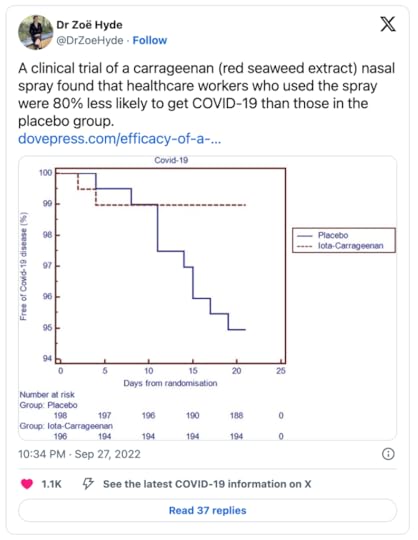
And they’re cheap, safe and well-proven! You don’t need a doctor’s prescription! You can find them at the pharmacy, but be sure to check they contain compounds like carrageenan, as there are a lot of saline-only sprays on the shelves.
Here in Australia, carrageenan is found in Flo Travel Nasal Spray. If you’re off to a Christmas party or think you might have been exposed to COVID, this is a good way to reduce your risk of disease.
Probiotics
Probiotics hold a lot of promise in combatting COVID, especially for kids.
Scientists are awesome. They will literally test anything and everything to see what works—but more than that, they ask, “Why does this work?” And sometimes, answers to complex problems come from unusual sources. In this case, a chewable probiotic that has shown anti-viral properties in the past turned out to be effective against COVID. This is particularly important for kids who are packed into classrooms and potentially exposed to COVID far more than adults.
Streptococcus salivarius K12 (BLIS K12) is a probiotic that is already known to reduce the incidence of tonsillitis and scarlet fever in kindergarteners by 80%. Realizing this, scientists wondered if it could be used to help hospitalized COVID patients and found it improved survival rates by a factor of three!
A randomized and controlled trial in Italy followed 128 children at school over 90 days (64 children took the K12 probiotic, while the other 64 children didn’t, acting as a control group). At the end of the trial, none of the children consuming K12 had caught COVID, while 24 children in the control group tested positive for COVID.
In a research paper entitled, Probiotic Effects against Virus Infections: New Weapons for an Old War, scientists note that “probiotic supplementation improved both barrier and biochemical immune responses, [and] decreased susceptibility to viral infections.“
Further research has shown that a healthy microbiome in the throat can multiply the effectiveness of antibodies (which result from vaccination or from fighting off a previous infection)
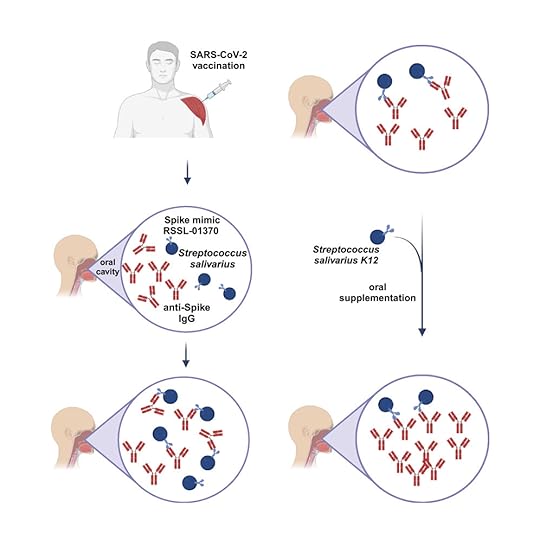
Probiotics aren’t appropriate for babies, but as children develop and begin mixing in high-risk viral areas like kindergarten and school, probiotics can provide an effective way to reduce a child’s risk of respiratory diseases like COVID and RSV.
And, again, like with the nasal sprays, these probiotics are available from a pharmacy without a prescription. Products like Bionaze are available from Amazon.
Disclaimer
I am not a medical doctor. This article is intended to help provide alternatives to the disinformation that is so prevalent on the internet and contains links to the underlying scientific research, but it should not be considered medical advice. As we each have our own unique medical history, you should discuss options like these with your doctor and seek their recommendations.
November 16, 2023
Retrograde (audiobook)
Until Dec 12th, 2023, the audiobook for Mars Retrograde is on sale for only $2.99!

I love audiobooks. For me, they bring stories to life in a way movies and TV shows can’t.
Every author wants to see at least one of their novels brought to life as a movie or a streaming series, but, honestly, it’s not nirvana. Movies and series are such vastly different formats that they demand changes to the content. Sometimes, that’s for the better, but not always.
Hugh Howey’s Wool was adapted to the Apple TV hit series Silo. Fans of the book, like myself, watched with intense interest as various differences unfolded. For the most part, the screenwriters were faithful to the source material, but there were a few headscratchers that were added simply to amp up the sense of mystery and keep the tension rolling from one episode to the next.
And so we come to audiobooks. A good narrator can bring a story to life in ways even the author only glimpsed at with the pacing and emotion they bring to the story.
If you’re looking for a great audiobook to listen to this month, check out Retrograde!
November 12, 2023
Giant Leaps
Recently, I came across a graph showing the heart rate of both Neil Armstrong and Buzz Aldrin during their moonwalk. Buzz was quite relaxed during the whole thing, while Armstrong’s heart rate was (understandably) elevated.
It’s fascinating to compare this with their actual activities.

Apollo 11 touched down in the Sea of Tranquility in 1969. If you can imagine the Eagle landing on the pitcher’s mound of a baseball field, you can get an idea about their movements. In essence, with this being the first of a number of planned missions, the goals for Apollo 11 were conservative. Their priorities were to land safely and bring back at least a contingency sample, but the real science and exploration would occur on later missions.
The yellow areas show where the astronauts walked, which was basically between first base and third base, with Neil being the only one to venture into the outfield. It was this particular walk that caused his heart rate to spike in the first graph. Whether that was from the physical exertion or the sense of trepidation in being so isolated, or perhaps a little bit of both, is difficult to tell. As they were venturing into the unknown, I’m pretty sure my heart rate would have been even higher.
When we think of the Apollo missions, it’s easy to lament the lack of human exploration in the last fifty years. Some have even suggested we’ve gone backward, but we haven’t. We’ve realized robots and probes are far more practical and capable and can travel far further with less cost and less risk, so we’ve sent out Voyager and Cassini and New Horizons to explore the solar system.
When it comes to human exploration, my 21-year-old daughter has NEVER known a time when there weren’t astronauts in space. We have had a continuous presence on the International Space Station for well over two decades now! Although it might seem like we’re only slowly gearing up for NASA’s Artemis missions to return to the Moon and eventually to head to Mars, we have gathered an astonishing amount of valuable experience with life on the International Space Station.
Honestly, Apollo was decades ahead of its time. What NASA was able to accomplish with slide rulers and antiquated computers is utterly astonishing. The keyfob you use to open your car door has more computing memory than the computer that guided Neil and Buzz to the lunar surface! Your iPhone is somewhere in the order of 100,000 times more powerful than the Apollo guidance computer.
Neil was prescient when he said, “This is one small step for (a) man. One giant leap for mankind.” Over half a century later, we’ve mapped the cosmic microwave background, we’ve imaged black holes, we’ve measured gravitational waves as black holes collide, and we’ve even seen planets orbiting other stars. We’re still making giant leaps!
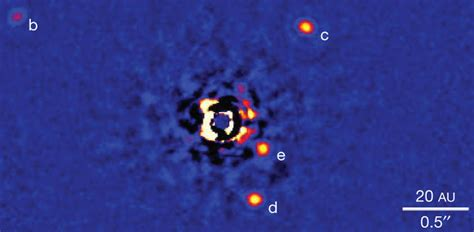
I’m looking forward to what comes next!

August 28, 2023
Artificial Intelligence is not intelligent
I do not use AI for writing in any shape, way or form. I use Grammarly for grammatical assistance while writing, but I have not (and will not) use either its “rewrite AI” (called Grammarly Go) or Chat GPT because these systems are mindless.
If someone uses AI when writing, I think they’ve misunderstood the point of writing itself. Writing is an art. The construction of a sentence, a paragraph, a chapter, a character, a plot arc, etc., are about making seasoned judgment calls and thinking about pacing and progression toward a goal. This is waaaaaay beyond the capability of anything AI spews out.
The whole notion of Artificial Intelligence is a misnomer. There’s no intelligence there at all. In fact, I’d argue there’s a complete lack of intelligence by AI and anyone using AI. The Cambridge Dictionary defines intelligence in this way…
Intelligence: the ability to learn, understand, and make judgments or have opinions that are based on reason:
Systems like Chat GPT have the ability to (machine) learn by consuming vast amounts of information, but they do not understand the information they have collected. They have no ability to make judgment calls and cannot form opinions based on reason; therefore, they are not intelligent. This is perhaps best illustrated by the concept of AI hallucinations. These are a case of “garbage in, garbage out.” When AI is on solid ground, meaning something that is well understood and well documented, it can produce meaningful content, like answering questions about physics, etc. But as soon as AI gets into obscure areas where genuine insights and rational thought are needed, it will fabricate well-meaning answers that can be completely bogus and misleading. And the reason is simple. There’s no understanding. There’s no reasoning. And this, in my opinion, makes AI dangerous as it can (and will) become a source/promulgator of misinformation. It will be misused by bad-faith actors to deceive people.

I have not and will not consent to any of my works of fiction being used to train an artificial intelligence, as even the notion of training is misleading. AI is not being trained. It’s simply undergoing complex pattern matching with the view to mimicking genuine content without ever actually producing genuine, original content.
AI is the modern-day equivalent of the Chinese Room thought experiment. Over three hundred years ago, back in 1714, German mathematician Gottfried Leibniz first challenged the notion that the human mind was just a complex machine and that it could be understood and replicated using mechanical processes. In 1980, John Searle expanded on Leibniz with what became known as the problem of the Chinese Room, meaning if you could feed enough Chinese information into a closed room, could someone without any knowledge of Chinese eventually give back meaningful sentences in Chinese without ever actually understanding Chinese at all? AI has proven that’s possible, but it’s not the success most people think it is. The point of the Chinese room is that this is done with NO understanding. And where there’s no understanding, there’s no value.
“Nobody supposes that the computational model of rainstorms in London will leave us all wet. But they make the mistake of supposing that the computational model of consciousness is somehow conscious.” — John Searle
Wikipedia entry for the Chinese Room

The ability to mimic intelligence is meaningless without intent. In nature, mimicry serves a purpose. The gopher snake mimics a rattlesnake to avoid predators. The anglerfish mimics a clump of seaweed, luring prey close enough to strike without warning. Artificial Intelligence, though, serves no purpose beyond plagiarism. Why are companies investing so heavily in AI? To make money. But how? By mimicking actual creativity without adding any real value. To my mind, AI is parasitic.
I think there is a place for Large-Language Machine Learning Artificial Intelligence in supporting scientific research. AI’s ability to connect-the-dots and find obscure, hidden relationships is invaluable when dealing with hundreds of thousands of peer-reviewed research papers where human reason and actual understanding have already been applied to complex topics. But note the difference in motivation. In this case, AI is being used to advance our scientific understanding. The problem is that’s not something that can be monetized, and money is the ONLY thing AI companies are interested in. They’re not actually interested in artificial intelligence; they’re interested in shortcuts to corner a market. To me, that’s shortsighted.
It’s said that “Fire is a wonderful servant, but a lousy master,” and I think the same is true of artificial intelligence. In the right context, AI can be a wonderful servant to humanity, but to have it in the driving seat is a mistake; to surrender our intellect to a machine-learning algorithm that neither understands nor cares about humanity is madness.



